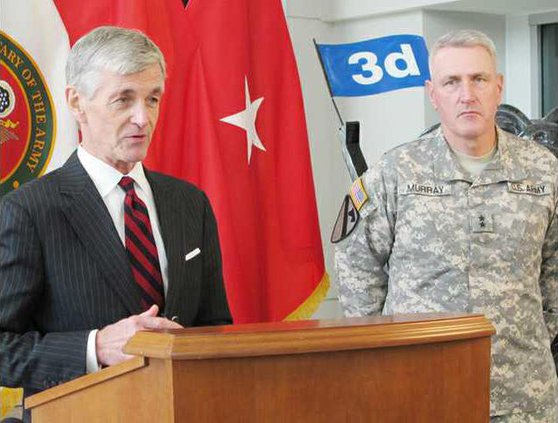Secretary of the Army John McHugh told reporters during a news conference Tuesday on Fort Stewart that the timeline for downsizing the Army has been stepped up from 2017 to 2015.
Fort Stewart’s 2nd Armor Brigade Combat Team is one of 12 brigade combat teams tagged for deactivation as part of the drawdown. McHugh said the net loss of soldiers from Fort Stewart would be about 1,900.
The secretary said that downsizing, “though never easy,” will help the Army face its budgetary challenges. He said the U.S. military historically draws down when conflicts end, and that is what is happening now. McHugh added that one of the lessons learned in Iraq and Afghanistan was that smaller units trained in multiple capabilities proved to be more effective.
The planned force reduction was spurred by the Budget Control Act of 2011. To meet new budget requirements, the Army plans to reduce current active-duty soldiers from 570,000 to 490,000, McHugh said.
He said the Army is unique among the armed forces, since personnel is where most of its funding goes and, therefore, that’s where the cuts must be made.
“The important thing, I think, for everyone to understand is that Fort Stewart was not singled out,” McHugh said. “Every multi-brigade post in the United States lost a brigade as well.”
He also stressed that Fort Stewart is a valuable asset to the Army, particularly with its proximity to the Savannah port.
The secretary also said civilian staffs at the headquarters level are targeted to be reduced by about 25 percent, but said the effects of these cuts “would be minimal” at Fort Stewart. McHugh went on to say the civilian workforce is underappreciated. They’ve suffered furloughs, pay freezes and have not had cost-of-living increases. He said the civilian workforce is critical to the Army’s success, and he is mindful of the impact budget cuts would have on them.
This was McHugh’s second visit to Fort Stewart. Earlier in the day, he met with senior leaders, including non-commissioned officers, observed a drone demonstration and visited Warriors Walk, stopping by Sgt. 1st Class Paul R. Smith’s memorial tree, according to 3rd ID public affairs officer Lt. Col. Benjamin Garrett. Smith was killed on April 4, 2003, in Iraq and posthumously was awarded the Medal of Honor.
McHugh outlines his top priorities for fiscal year 2014 on army.mil. Preventing sexual assault heads the secretary’s list of issues to tackle, followed by balance and transition the Army; champion soldiers, civilians and families; bolster Army activities in the Asia-Pacific region; ensure personal accountability on and off the battlefield; tell the Army story; implement Army total-force policy; prudently manage reset, modernization, research and development; strengthen information assurance and cyber security; and develop effective energy solutions.
Army secretary: Downsizing is typical
Fort Stewart to shed brigade by 2015


Sign up for our e-newsletters